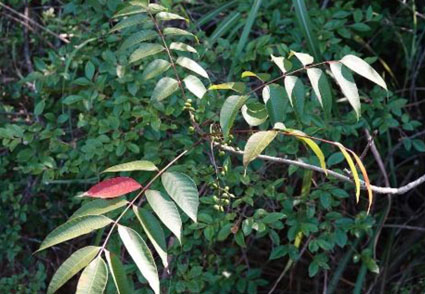Abstract
A new species of Anacardiaceae, Toxicodendron oligophyllum S. L. Tang, Liang Ma & S. P. Chen, from eastern Fujian Province, China, is described and illustrated. Morphologically, the leaf of T. oligophyllum includes only 3–5 leaflets which is the least number in all known species of Toxicodendron. Additionally, the length of inflorescence equal to which of the leaf can also be used as a well diagnostic characters to distinguish the new species from the other Toxicodendron. The phylogeny of Toxicodendron using the nuclear ribosomal internal transcribed spacer (nrITS) and chloroplast (trnL-F) sequences was reconstructed. The result showed the new species is sister to T. sylvestre (Sieb. & Zucc.) Kuntze.
References
IUCN (2019) The IUCN Red List Categories and Criteria, Version 2019-2. Available from: http://www.iucnredlist.org/(accessed 18 July 2019).
Jiang, Y., Gao, M., Meng, Y., Wen, J., Ge, X.J., Nie, Z.L. (2019) The importance of the North Atlantic land bridges and eastern Asia in the post-Boreotropical biogeography of the Northern Hemisphere as revealed from the poison ivy genus (Toxicodendron, Anacardiaceae). Molecular Phylogenetics and Evolution 139: 106561. https://doi.org/10.1016/j.ympev.2019.106561
Kuntze, C.E.O. (1891) Revisio Generum Plantarum. Arthur Felix, Leipzig, pp. 1–374.
Li, Y., Tang, Y., Wu, T. (2020) The complete chloroplast genome of Toxicodendron griffithii. Mitochondrial DNA Part B 5 (2): 2211–2212.
Min, T.L. (1980a) The geographic distribution and floristic character of Chinese Anacardiaceae. Acta Botanica Yunnanica 2: 390–401.
Min, T.L. (1980b) Anacardiaceae. In: Cheng, M., Min, T.L. (Ed.) Flora Reipublicae Popularis Sinicae, Vol. 45 (1). Science Press, Beijing, pp. 66–135.
Min, T.L., Anders, B. (2009) Toxicodendron. In: Wu, Z.Y., Raven, P.H. & Hong, D.Y. (Eds.) Flora of China. Vol. 11. Science Press, Beijing & Missouri Botanical Garden Press, St. Louis, pp. 348–354.
Miller, M.A., Pfeiffer, W. & Schwartz, T. (2010) Creating the CIPRES Science Gateway for inference of large phylogenetic trees. In: Proceedings of the Gateway Computing Environments Workshop (GCE). 14 Nov. 2010, New Orleans, LA, pp. 1–8.
Miller, P. (1754) The Gardener’s Dictionary, Abridged 4 ed. Printed by the Author, London, without pagination.
Nie, Z.L., Sun, H., Meng, Y. & Wen, J. (2009) Phylogenetic analysis of Toxicodendron (Anacardiaceae) and its biogeographic implications on the evolution of north temperate and tropical intercontinental disjunctions. Journal of Systematics and Evolution 47 (5): 416–430. https://doi.org/10.1111/j.1759–6831.2009.00045.x
Stamatakis, A. (2014) RAxML version 8: a tool for phylogenetic analysis and post-analysis of large phylogenies. Bioinformatics 30: 1312–1313.
Swofford, D. (2003) PAUP: phylogenetic analysis using parsimony and other methods. Version 4. Sinauer Associates, Sunderland, MA.
Wang, L., He, N., Li, Y., Fang, Y., Zhang, F. (2020) Complete chloroplast genome sequence of Chinese lacquer tree (Toxicodendron vernicifluum, Anacardiaceae) and its phylogenetic significance. BioMed Research International 2020: 9014873. https://doi.org/10.1155/2020/9014873
Yi, T., Miller, A.J. & Wen, J. (2004) Phylogenetic and biogeographic diversification of Rhus (Anacardiaceae) in the Northern Hemisphere. Molecular Phylogenetics and Evolution 33: 861–879. https://doi.org/10.1016/j.ympev.2004.07.006


